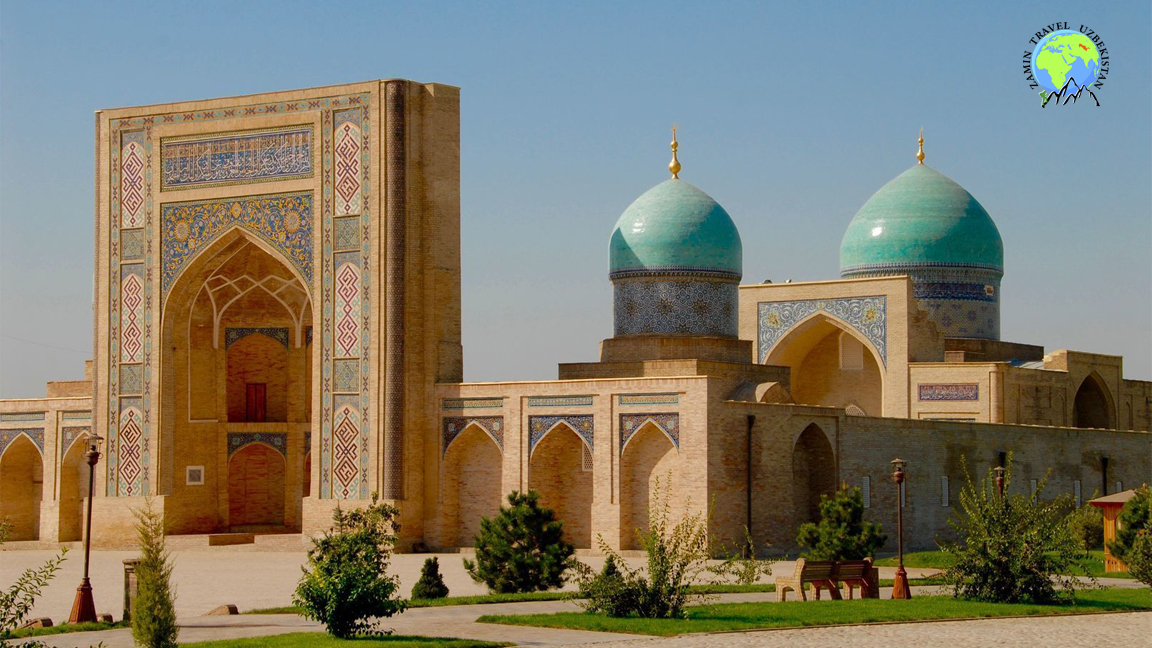


In the old residential area of Tashkent Sebzor is Khazrat Imam Square with a complex of architectural monuments that were built over several centuries. Scientists believe that this place served as a city center in the early Middle Ages and was called "Shash". The ensemble of monuments began its form around the tomb of Kaffal al-Shashi, the first imam and propagator of Islam in Tashkent. The place was named after him: Khazrat Imam ("Holy Imam"). The Imam al-Bukhari Islamic University is located near the mausoleum of Kaffal al-Shashi. It is located in the former "Namazgokh" mosque which was built in the 19th century. The building is decorated with national “ganch stucco carvings” and patterned paintings. The university was founded in 1970 and has since become an authoritative higher education institution in the Muslim world. The Khazrat Imam complex also includes the building of the Office of the Administration of Muslims in Uzbekistan. Nearby is the Juma Mosque, which was built on the old foundations in the 19th century and was repeatedly reconstructed in later times. This mosque is used for Friday prayers and wedding ceremonies. Opposite the mosque is the Muslim Administration Office library, which contains over 30,000 religious and secular books. Among them are 2,000 valuable rarities: richly illustrated manuscripts from the 16th century, unique patterns of calligraphy and exquisitely decorated Koran books that were given to the Bureau of the Administration of Muslims by the leaders of the Islamic countries. The best preserved holy Koran, which can be seen in the special room of the library, is particularly valuable. The fourth construction of the Khazrat Imam Square complex is a huge Friday mosque with bright turquoise domes. It was built in our time in the best tradition of Central Asian architecture. Two huge 56 meter high minarets flank the entrance to the mosque in the caravanserai road. Khazrat Imam Complex has been considered the center of Islamic culture in Uzbekistan for more than a thousand years.
Barak Khan madrasah
Near the Khazrat Imam Square is the Barak-Khan Madrasa, one of the most remarkable medieval architectural monuments. The culmination of its portal is decorated with majolica and glazed tiles and accented by a deep lancet with small decorative arches. The corners of the facade are lined with flower-filled towers with small domes. Behind the artistically engraved doors, a small rectangular courtyard is surrounded by hujra cells and a large “darskhona” (room for lectures). The dome of the Darskhona rests on juxtaposed arches, whose Gussets are decorated with delicate "gunch stucco". The interior walls are covered with paintings. The design of the Barak-Khan Madrasah differs significantly from the traditional structures of its kind. It is in fact a complex of structures surrounded by a madrasah and two older mausoleums. On the left side of the madrasah is the oldest building in the complex, a mausoleum of an unknown clergyman. In the vicinity of the complex there was the domed mausoleum in 1531, built by Suyuniy Khan, the first ruler of Tashkent province from the Uzbek Sheibanid dynasty. The mausoleum was richly decorated with engravings and gilded but later numerous reconstructions were carried out. In the middle of the 16th century, Suyunij-Khan's son, Nawruz-Ahmad, also known as Barak-Khan, built a madrasah on his father's mausoleum. The central hall is crowned with a turquoise dome on a tall cylinder. Similar domes crown the mausoleum of an unknown clergyman and the "darskhona" of the madrasah. The Barak-Khan Madrasah housed the office of administration for Muslims for many decades. After the office moved to another new building, the cells of the madrasah were made available to craftsmen who worked on it for many years for the reconstruction. In the shadow of the old madrasah, the craftsmen carefully drew Arabic characters (Ayats from the Koran).